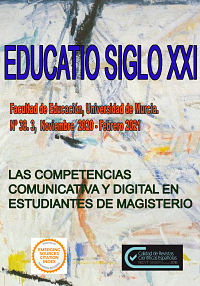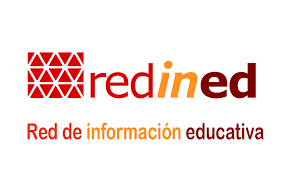Uso de la evidencia y significatividad histórica en la enseñanza de la Transición española mediante un entorno digital de aprendizaje
Resumen
INTRODUCCIÓN. Este estudio, enmarcado en el Proyecto HISREDUC, recoge los resultados obtenidos tras una intervención en la asignatura Geografía e Historia de cuarto curso de la ESO. MÉTODO. Se establece el objetivo de facilitar el desarrollo de dos dimensiones del pensamiento histórico (el uso de la evidencia y la percepción de la significatividad), mediante la aplicación de un entorno digital de aprendizaje durante siete sesiones, con un total de 53 estudiantes, y utilizando la enseñanza de la Transición española como marco curricular de trabajo. Mediante el uso de un análisis cualitativo, se examina el grado de progresión mostrado en torno a ambas dimensiones, comparando el nivel de competencia presente antes y después de la aplicación del entorno digital. RESULTADOS. Los resultados permiten identificar patrones comunes ligados con las habilidades de los estudiantes, mostrando una evolución positiva en relación con el uso de la evidencia y con la comprensión de la significatividad histórica. DISCUSIÓN. se concluye que la intervención didáctica utilizada ha reforzado y ayudado a hacer explícitas capacidades latentes, facilitando su aplicación en el análisis del pasado.
Descargas
-
Resumen1247
-
PDF771
Citas
Carretero, M., y Bermúdez, Á. (2012). Constructing Histories. En J. Valsiner (Ed.), The Oxford Handbook of Culture and Psychology (pp. 625-648). New York: Oxford University Press.
Cercadillo, L., Chapman, A., y Lee, P. (2017). Organizing the Past: Historical Accounts, Significance and Unknown Ontologies. En M. Carretero, S. Berger, y M. Grever (Eds.), Palgrave Handbook of Research in Historical Culture and Education (pp. 553-572). London: Palgrave.
Chapman, A. (2014). «But it Might Not Just Be Their Political Views»: Using Jörn Rüsen’s «Disciplinary Matrix» to Develop Understandings of Historical Interpretation. Cadernos de Pesquisa, 9(21), 67-85.
Cohen, L., Manion, L., y Morrison, K. (2005). Research Methods in Education (5.a ed.). London: Routledge.
Corbin, J., y Strauss, A. (2015). Basics of Qualitative Research: Techniques and Procedures for Developing Grounded Theory. Thousand Oaks: SAGE Publications.
Domínguez, J. (2015). Pensamiento histórico y evaluación de competencias. Barcelona: Graó.
Gómez, C. J., Ortuño, J., y Molina, S. (2014). Aprender a pensar históricamente. Retos para la historia en el siglo XXI. Tempo e Argumento, 6(11), 5-27. doi:10.5965/2175180306112014005
González, N., Pagès, J., y Santisteban, A. (2011). ¿Cómo evaluar el pensamiento histórico del alumnado? En P. Miralles, S. Molina, y A. Santisteban (Eds.), La evaluación en el proceso de enseñanza y aprendizaje de las Ciencias Sociales (pp. 221-232). Murcia: Universidad de Murcia y AUPDCS.
Haydn, T. (2011). History Teaching and ICT. En I. Davies (Ed.), Debates in History Teaching (pp. 236-248). London: Routledge.
Hernández-Sampieri, R., Fernández-Collado, C., y Baptista-Lucio, P. (2014). Metodología de la investigación (6.a ed.). México: McGraw-Hill.
Kee, K.B. (Ed.). (2014). Pastplay: Teaching and Learning History with Technology. Ann Arbor: University of Michigan Press. doi:10.3998/dh.12544152.0001.001
Lee, P. (2005). Putting Principles into Practice: Understanding History. En M.S. Donovan y J.D. Bransford (Eds.), How Students Learn: History in the Classroom (pp. 31-78). Washington, D.C.: The National Academies Press.
Lévesque, S. (2008). Thinking Historically: Educating Students for the Twenty-First Century. Toronto: University of Toronto Press.
Lévesque, S., y Clark, P. (2018). Historical Thinking: Definitions and Educational Applications. En S. Metzger y L.M. Harris (Eds.), The Wiley International Handbook of History Teaching and Learning (pp. 119-148). Malden: Wiley.
Rüsen, J. (2005). History: Narration, Interpretation, Orientation. New York: Berghahn Books.
Sáiz-Serrano, J., y López-Facal, R. (2015). Competencias y narrativas históricas: el pensamiento histórico de estudiantes y futuros profesores españoles de educación secundaria. Revista de Estudios Sociales, (52), 87-101. doi:10.7440/res52.2015.06
Sánchez-Agustí, M., Vásquez Lara, N., y Vásquez Leyton, G. (2016). Understanding The Processes Of Transition From Dictatorship To Democracy. A Survey Among Secondary Schools Students In Chile. International Journal of Historical Learning Teaching and Research, 13(2), 23-34.
Seixas, P. (2017). A Model of Historical Thinking. Educational Philosophy and Theory, 49(6), 593-605. doi:10.1080/00131857.2015.1101363
Seixas, P., y Morton, T. (2013). The Big Six Historical Thinking Concepts. Toronto: Nelson.
Spector, J.M., Merrill, M.D., Elen, J., y Bishop, M.J. (Eds.). (2014). Technology-Based Instructional Design: Evolution and Major Trends. En Handbook of Research on Educational Communications and Technology (4.a ed., pp. 661-671). London: Springer.
Stake, R.E. (2010). Qualitative Research. Studying How Things Work. New York: The Guilford Press.
Stoel, G.L., van Drie, J., y van Boxtel, C. (2017). The Effects of Explicit Teaching of Strategies, Second-Order Concepts, and Epistemological Underpinnings on Students’ Ability to Reason Causally in History. Journal of Educational Psychology, 109(3), 321-337. doi:10.1037/edu0000143
Van Boxtel, C., y van Drie, J. (2018). Historical Reasoning: Conceptualizations and Educational Applications. En S. Alan Metzger y L.M. Harris (Eds.), The Wiley International Handbook of History Teaching and Learning (pp. 149-176). New York: Wiley-Blackwell.
VanSledright, B.A. (2004). What Does It Mean to Think Historically... and How Do you Teach It? Social Education, 68(3), 230-233.
VanSledright, B.A., y Limón, M. (2006). Learning and Teaching Social Studies: A Review of Cognitive Research in History and Geography. En P.A. Alexander y P.H. Winne (Eds.), Handbook of Educational Psychology (2.a ed., pp. 545-570). New York: Routledge.
Wineburg, S. (2001). Historical Thinking and Other Unnatural Acts: Charting the Future of Teaching the Past. Philadelphia: Temple University Press.
Wineburg, S., Martin, D., y Monte-Sano, C. (2013). Reading Like a Historian. Teaching Literacy in Middle & High School History Classrooms. New York: Teachers College Press.

Esta obra está bajo una licencia internacional Creative Commons Atribución-NoComercial-SinDerivadas 4.0.
Las obras que se publican en esta revista están sujetas a los siguientes términos:
1. El Servicio de Publicaciones de la Universidad de Murcia (la editorial) conserva los derechos patrimoniales (copyright) de las obras publicadas, y favorece y permite la reutilización de las mismas bajo la licencia de uso indicada en el punto 2.
2. Las obras se publican en la edición electrónica de la revista bajo una licencia Creative Commons Reconocimiento-NoComercial-SinObraDerivada 4.0 Internacional (texto legal). Se pueden copiar, usar, difundir, transmitir y exponer públicamente, siempre que: i) se cite la autoría y la fuente original de su publicación (revista, editorial y URL de la obra); ii) no se usen para fines comerciales; iii) se mencione la existencia y especificaciones de esta licencia de uso.
3. Condiciones de auto-archivo. Se permite y se anima a los autores a difundir electrónicamente las versiones pre-print (versión antes de ser evaluada) y/o post-print (versión evaluada y aceptada para su publicación) de sus obras antes de su publicación, ya que favorece su circulación y difusión más temprana y con ello un posible aumento en su citación y alcance entre la comunidad académica. Color RoMEO: verde.











